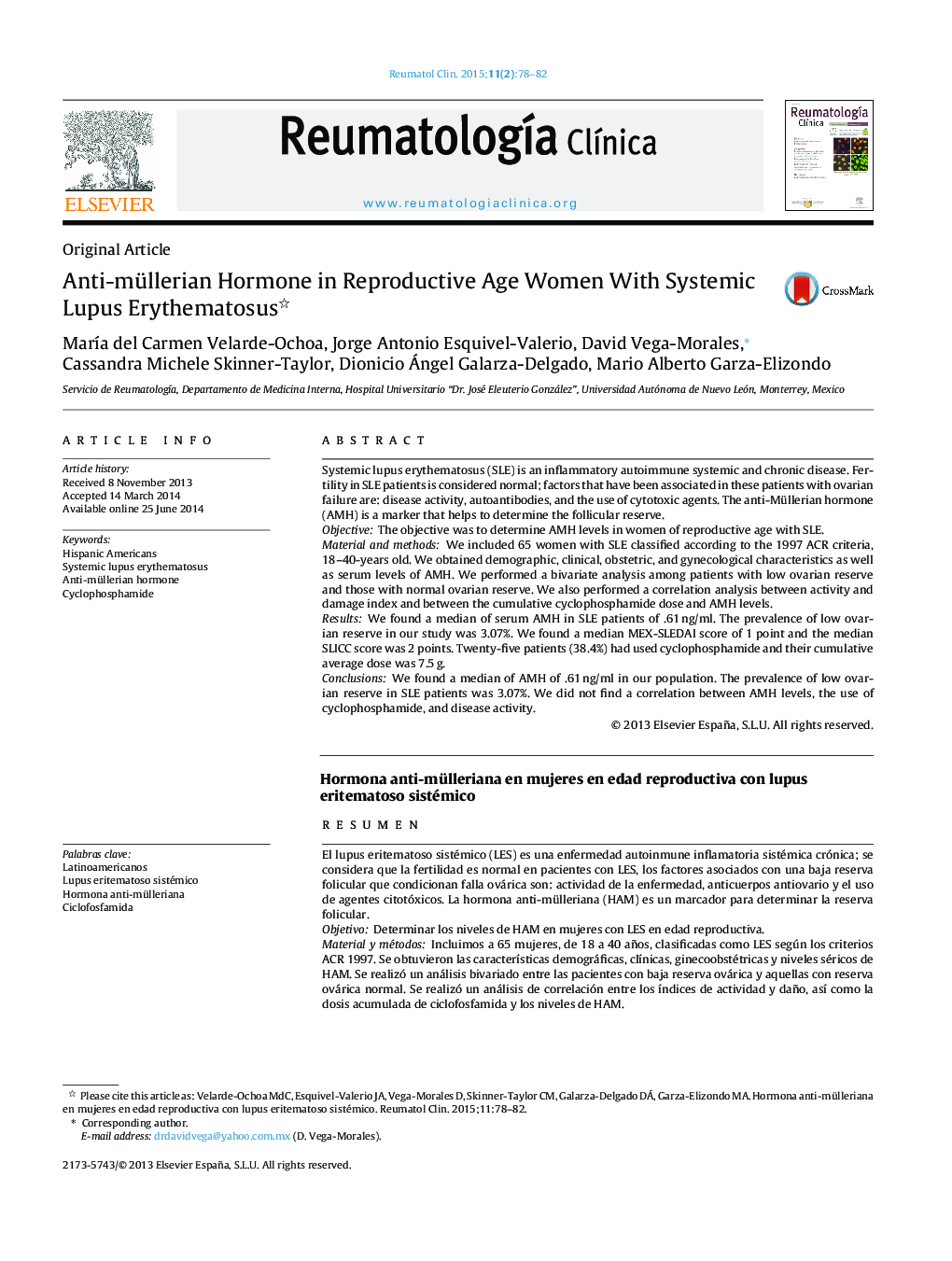| کد مقاله | کد نشریه | سال انتشار | مقاله انگلیسی | نسخه تمام متن |
|---|---|---|---|---|
| 3384150 | 1220514 | 2015 | 5 صفحه PDF | دانلود رایگان |

Systemic lupus erythematosus (SLE) is an inflammatory autoimmune systemic and chronic disease. Fertility in SLE patients is considered normal; factors that have been associated in these patients with ovarian failure are: disease activity, autoantibodies, and the use of cytotoxic agents. The anti-Müllerian hormone (AMH) is a marker that helps to determine the follicular reserve.ObjectiveThe objective was to determine AMH levels in women of reproductive age with SLE.Material and methodsWe included 65 women with SLE classified according to the 1997 ACR criteria, 18–40-years old. We obtained demographic, clinical, obstetric, and gynecological characteristics as well as serum levels of AMH. We performed a bivariate analysis among patients with low ovarian reserve and those with normal ovarian reserve. We also performed a correlation analysis between activity and damage index and between the cumulative cyclophosphamide dose and AMH levels.ResultsWe found a median of serum AMH in SLE patients of .61 ng/ml. The prevalence of low ovarian reserve in our study was 3.07%. We found a median MEX-SLEDAI score of 1 point and the median SLICC score was 2 points. Twenty-five patients (38.4%) had used cyclophosphamide and their cumulative average dose was 7.5 g.ConclusionsWe found a median of AMH of .61 ng/ml in our population. The prevalence of low ovarian reserve in SLE patients was 3.07%. We did not find a correlation between AMH levels, the use of cyclophosphamide, and disease activity.
ResumenEl lupus eritematoso sistémico (LES) es una enfermedad autoinmune inflamatoria sistémica crónica; se considera que la fertilidad es normal en pacientes con LES, los factores asociados con una baja reserva folicular que condicionan falla ovárica son: actividad de la enfermedad, anticuerpos antiovario y el uso de agentes citotóxicos. La hormona anti-mülleriana (HAM) es un marcador para determinar la reserva folicular.ObjetivoDeterminar los niveles de HAM en mujeres con LES en edad reproductiva.Material y métodosIncluimos a 65 mujeres, de 18 a 40 años, clasificadas como LES según los criterios ACR 1997. Se obtuvieron las características demográficas, clínicas, ginecoobstétricas y niveles séricos de HAM. Se realizó un análisis bivariado entre las pacientes con baja reserva ovárica y aquellas con reserva ovárica normal. Se realizó un análisis de correlación entre los índices de actividad y daño, así como la dosis acumulada de ciclofosfamida y los niveles de HAM.ResultadosLa mediana del título de HAM fue de 0,61 ng/ml. La prevalencia de baja reserva ovárica en nuestro estudio fue del 3,07%. La mediana del MEX-SLEDAI fue de 1 punto y la de SLICC 2 puntos. Veinticinco pacientes (38,4%) habían utilizado ciclofosfamida y la dosis promedio acumulada fue de 7,5 g.ConclusionesEn nuestra población, se encontró una mediana del título de HAM de 0,61 ng/ml, similar a lo reportado anteriormente. La prevalencia de baja reserva ovárica fue del 3,07%. No se encontró correlación entre el uso de ciclofosfamida, la actividad de la enfermedad o los niveles de HAM.
Journal: Reumatología Clínica (English Edition) - Volume 11, Issue 2, March–April 2015, Pages 78–82